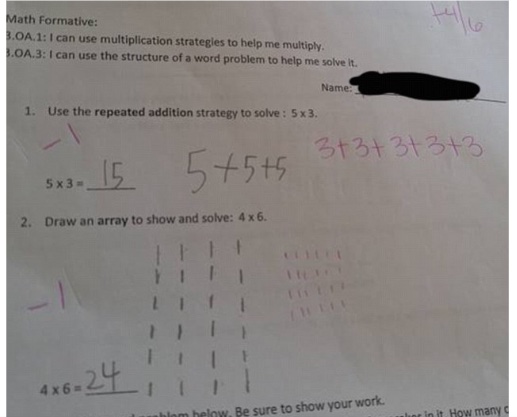Karen Wootton, Director of Curriculum and Assessment
Some of you might have seen the post about a third-grader’s quiz responses and the teacher’s scoring that has outraged parents, pundits and various bloggers. The two problems in question are shown below. What is at issue, if you have missed the controversy, is that the student was marked wrong for saying 5 x 3 = 5 + 5 + 5 = 15. We know that the mathematical equation the student wrote is correct, so why was the problem marked as incorrect? We need to consider the skill the teacher might have been trying to assess. “Use the repeated addition strategy to solve 5 x 3” the first question reads. Because of the teacher’s response, we know that the teacher was trying to illicit the response 3 + 3 + 3 + 3 + 3. Should the teacher have marked the problem as incorrect for the student’s response? This is a tough question to answer. There are some who see this as cut and dry: “The student has the right answer so should receive full credit” versus “The teacher wants to know if the student understands that 5 x 3 means five groups of three.” We see in the second question, also marked wrong, that the student made the same “error” creating an array representing 4 x 6 that has six rows of four rather than four rows of six.

Clearly there are issues here. The student demonstrated that s/he does understand that multiplication can be represented as repeated addition and as an array. And, given the first standard listed at the top of the quiz, “I can use multiplication strategies to help me multiply” the student has demonstrated proficiency for this standard. I also think though, that the teacher was looking for a different understanding, that the student can read 5 x 3 as “five groups of three,” and with this quiz, we do not know if the student really understands this. If the student had said “5 x 3 is the same as 3 x 5 which means 5 + 5 + 5” I would hope the teacher would have given full credit. After all, I think we can all agree that when you are a third grader, 5 + 5 + 5 is easier to compute than 3 + 3 + 3 + 3 + 3. In fact, maybe the student should receive bonus points for seeing the easier problem!
Let us use this problematic question to think more deeply about this. How could the teacher have asked the question if she wanted “3 + 3 + 3 + 3 + 3” as the answer? Would it have sufficed to ask “Write out in words what 5 x 3 means” or is that still up for debate? What if she had asked “List all the things 5 x 3 could represent”? What would the teacher have learned from the student’s response to this question? If the teacher only wanted to know whether the student could say that 5 x 3 means “five groups of three,” why not just ask “5 x 3 means _____ groups of _____” and have the student fill in the blanks? If we are trying to assess something basic, the question does not need to be tricky or complicated. But, if the teacher wants to assess whether or not the student understands what multiplication means, she should ask for more than “fill in the blanks,” perhaps something like “Five people each had three cats. How many cats were there altogether?”
The third grader’s quiz led some parents to denounce Common Core as a great evil torturing our children, and I think we need to make sure parents understand that the issue with this quiz really has nothing to do with Common Core. Yes, Common Core might ask for multiple strategies, which the teacher was trying to assess. But as with many Common Core-instigated outrages, this is an issue of implementation, not an issue with Common Core. Not only do we need to help parents understand this distinction, we also need to be careful when we craft our assessments that the questions are targeting the information we wish to learn. Every time we write a question for a quiz or test, we need to think carefully about the possible responses whether or not it is for a Common Core standard. It is never fair to have the student guess what you are thinking or what you might be looking for when you write a question. The question must not be ambiguous. This does not mean the problem cannot have embedded ambiguity or be open-ended, because it can. The ambiguity though cannot be in the question statement itself. The next time you craft a question for your students, think about the response you would like students to give, and ask yourself if your students will likely give the anticipated response. How will you support your students so they can show you what they know?